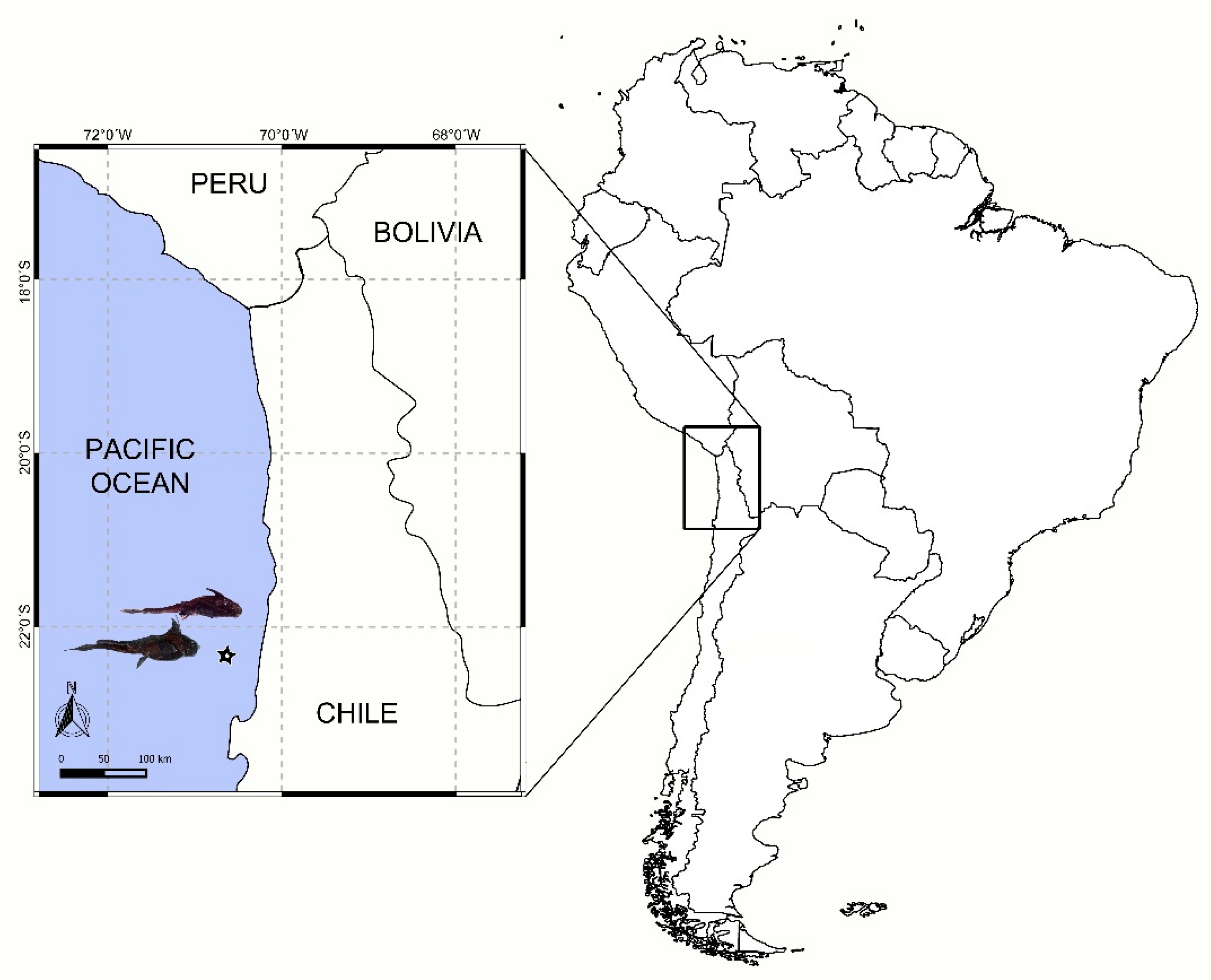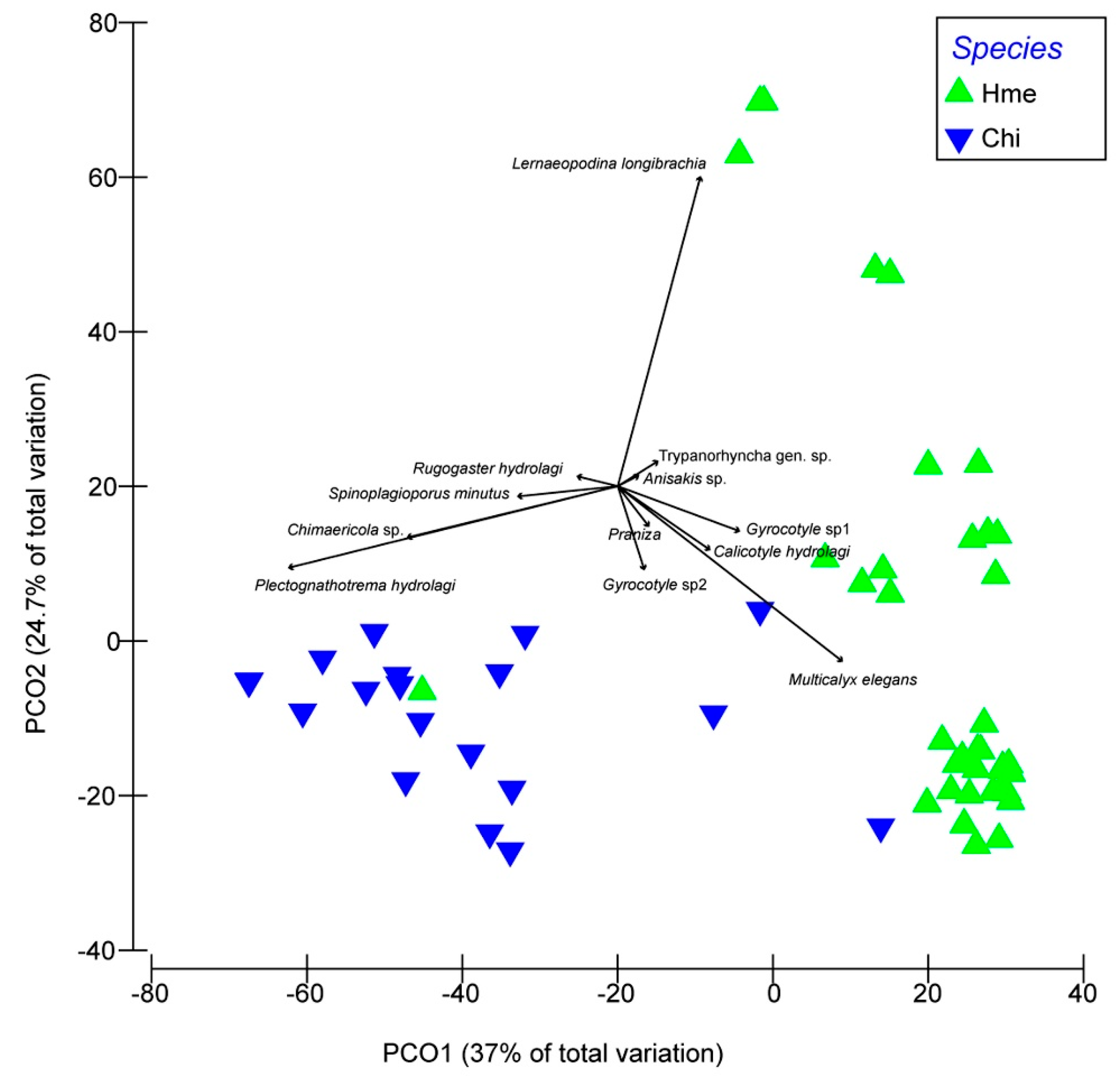Metazoan Parasite Communities of Two Sympatric Shortnose Chimeras (Holocephali: Chimaeridae) from Deep Waters Associated with the Humboldt Current System: Ancient Fishes Harbor Ancient Parasites
Abstract
1. Introduction
2. Materials and Methods
3. Results
4. Discussion
Supplementary Materials
Author Contributions
Funding
Institutional Review Board Statement
Data Availability Statement
Acknowledgments
Conflicts of Interest
References
- Korostelev, N.B.; Frey, P.H.; Orlov, A.M. Using Different Hard Structures to Estimate the Age of Deep-Sea Fishes: A Case Study of the Pacific Flatnose, Antimora microlepis (Moridae, Gadiformes, Teleostei). Fish. Res. 2020, 232, 105731. [Google Scholar] [CrossRef]
- Drazen, J.C.; Sutton, T.T. Dining in the Deep: The Feeding Ecology of Deep-Sea Fishes. Ann. Rev. Mar. Sci. 2017, 9, 337–366. [Google Scholar] [CrossRef]
- Bamford, C.C.G.; Hollyman, P.R.; Abreu, J.; Darby, C.; Collins, M.A. Spatial, temporal, and demographic variability in patagonian toothfish (Dissostichus eleginoides) spawning from twenty-five years of fishery data at South Georgia. Deep Sea Res. Part I Oceanogr. Res. Pap. 2024, 203, 104199. [Google Scholar] [CrossRef]
- Norse, E.A.; Brooke, S.; Cheung, W.W.L.; Clark, M.R.; Ekeland, I.; Froese, R.; Gjerde, K.M.; Haedrich, R.L.; Heppell, S.S.; Morato, T.; et al. Sustainability of deep-sea fisheries. Mar. Policy 2012, 36, 307–320. [Google Scholar] [CrossRef]
- Armstrong, C.W.; Foley, N.S.; Tinch, R.; van den Hove, S. Services from the deep: Steps towards valuation of deep-sea goods and services. Ecosyst. Serv. 2012, 2, 2–13. [Google Scholar] [CrossRef]
- Klimpel, S.; Busch, M.W.; Kellermanns, E.; Kleinertz, S.; Palm, H.W. Metazoan deep-sea fish parasites. In Acta Biologica Benrodis; Natur & Wissen: Solingen, Germany, 2009; 384p. [Google Scholar]
- Dobson, A.; Lafferty, K.D.; Kuris, A.M.; Hechinger, R.F.; Jetz, W. Homage to Linnaeus: How many parasites? How many hosts? Proc. Natl. Acad. Sci. USA 2008, 105, 11482–11489. [Google Scholar] [CrossRef]
- Moore, S.E.; Siwertsson, A.; Lafferty, K.D.; Kuris, A.M.; Soldanova, M.; Morton, D.; Primicerio, R.; Amundsen, P.A. Parasites alter food-web topology of a subarctic lake food web and its pelagic and benthic compartments. Oecologia 2024, 204, 257–277. [Google Scholar] [CrossRef]
- Beer, A.; Ingram, T.; Randhawa, H.S. Role of ecology and phylogeny in determining tapeworm assemblages in skates (Rajiformes). J. Helminthol. 2019, 93, 738–751. [Google Scholar] [CrossRef]
- Klimpel, S.; Palm, H.W.; Busch, M.W.; Kellermanns, E.; Rückert, S. Fish parasites in the Arctic deep-sea: Poor diversity in pelagic fish species vs. heavy parasite load in a demersal fish. Deep Sea Res. Part I Oceanogr. Res. Pap. 2006, 53, 1167–1181. [Google Scholar] [CrossRef]
- Espínola-Novelo, J.F.; Oliva, M.E. Spatial and Temporal Variability of Parasite Communities: Implications for Fish Stock Identification. Fishes 2021, 6, 71. [Google Scholar] [CrossRef]
- Froese, R.; Pauly, D. (Eds.) FishBase. Chimaera Linnaeus. 1758. Available online: https://www.marinespecies.org/aphia.php?p=taxdetails&id=105733 (accessed on 30 June 2025).
- Morris, T.C.; Ploeg, J.; Awa, S.B.; Lingen, C.; Reed, C.C. Parasite community structure as a predictor of host population structure: An example using Callorhinchus capensis. Int. J. Parasitol. Parasites Wildl. 2019, 8, 248–255. [Google Scholar] [CrossRef]
- Inoue, J.G.; Miya, M.; Lam, K.; Tay, B.-H.; Danks, J.A.; Bell, J.; Walker, T.I.; Venkatesh, B. Evolutionary Origin and Phylogeny of the Modern Holocephalans (Chondrichthyes: Chimaeriformes): A Mitogenomic Perspective. Mol. Biol. Evol. 2010, 27, 2576–2586. [Google Scholar] [CrossRef]
- Dieske, H. A survey of the metazoan parasites of the rabbit-fish, Chimaera mostrosa L. (Holocephali). Neth. J. Sea Res. 1968, 4, 32–58. [Google Scholar] [CrossRef]
- Karlsbakk, E.; Aspholm, P.E.; Berg, V.; Hareide, N.R.; Berland, B. Some parasites of the small-eyed rabbitfish, Hydrolagus affinis (Capello, 1867) (Holocephali), caught in deep waters off SW Greenland. Sarsia 2002, 87, 179–184. [Google Scholar] [CrossRef]
- Rey, C.; Minaya, D.; Iannacone, J. Community of metazoan parasites of the cockfish Callorhinchus callorynchus (Linnaeus, 1758) (Chimaeriformes: Callorhinchidae) from artisanal fishing in Pisco, Ica, Peru. Rev. Mus. Argent. Cienc. Nat. 2021, 24, 77–87. [Google Scholar]
- Fernández, J.C.; Villalba, C.S.; Alviña, A. Parásitos del pejegallo, Callorhinchus callorhynchus, en Chile: Aspectos biológicos y sistemáticos. Biol. Pesq. 1986, 15, 63–73. [Google Scholar] [CrossRef]
- Ñacari, L.A.; Oliva, M.E. Metazoan parasites of deep-sea fishes from the South Eastern Pacific: Exploring the role of ecology and host phylogeny. Deep Sea Res. Part I Oceanogr. Res. Pap. 2016, 115, 123–130. [Google Scholar] [CrossRef]
- Bush, A.O.; Lafferty, K.D.; Lotz, J.M.; Shostak, A.W. Parasitology meets ecology on its own terms: Margolis et al. revisited. J. Parasitol. 1997, 83, 575–583. [Google Scholar] [CrossRef]
- Clarke, K.R.; Gorley, R.N. Primer v6: User Manual/Tutorial. Primer-E; Plymouth Marine Laboratory: Plymouth, UK, 2006; 193p. [Google Scholar]
- Espínola-Novelo, J.F.; Escribano, R.; Oliva, M.E. Metazoan parasite communities of two deep-sea elasmobranchs: The southern lanternshark, Etmopterus granulosus and the largenose catshark, Apristurus nasutus, in the Southeastern Pacific Ocean. Parasite 2018, 25, 53. [Google Scholar] [CrossRef]
- Derouiche, I.; Neifar, L.; Gey, D.; Justine, J.-L.; Tazerouti, F. Holocephalocotyle monstrosae n. gen. n. sp. (Monogenea, Monocotylidae) from the olfactory rosette of the rabbit fish, Chimaera monstrosa (Holocephali, Chimaeridae) in deep waters off Algeria. Parasite 2019, 26, 59. [Google Scholar] [CrossRef]
- Bray, R.A.; Waeschenbach, A.; Littlewood, D.T.J.; Halvorsen, O.; Olson, P.D. Molecular circumscription of new species of Gyrocotyle Diesing, 1850 (Cestoda) from deep-sea chimaeriform holocephalans in the North Atlantic. Syst. Parasitol. 2020, 97, 285–296. [Google Scholar] [CrossRef]
- Barčák, D.; Fan, C.-K.; Sonko, P.; Kuchta, R.; Scholz, T.; Orosová, M.; Chen, H.-W.; Oros, M. Hidden diversity of the most basal tapeworms (Cestoda, Gyrocotylidea), the enigmatic parasites of holocephalans (Chimaeriformes). Sci. Rep. 2021, 11, 5492. [Google Scholar] [CrossRef]
- Kitamura, A.; Ogawa, K.; Taniuchi, T.; Hirose, H. Two new species of hexabothriid monogeneans from the ginzame Chimaera phantasma and shortspine spurdog Squalus mitsukurii. Syst. Parasitol. 2006, 65, 151–159. [Google Scholar] [CrossRef] [PubMed]
- Oldewage, W.H. A new species of Vanbenedenia Maim, 1860 (Copepoda: Lernaeopodidae) from the Southern Indian Ocean. Syst. Parasitol. 1993, 26, 137–140. [Google Scholar] [CrossRef]
- Thoney, D.A.; Burreson, E.M. Revision of the Multicalycidae (Aspidocotylea) with Comments on Postlarval Development. Proc. Helminthol. Soc. Wash. 1988, 55, 62–67. [Google Scholar]
- Amato, J.F.R.; Pereira, J. A new species of Rugogaster (Aspidobothrea: Rugogastridae) parasite of the elephant fish, Callorhinchus callorhynchus (Callorhinchidae), from the estuary of the La Plata River, Coasts of Uruguay and Argentina. Rev. Bras. Parasitol. 1995, 4, 1–7. [Google Scholar]
- Olson, R.E.; Hanson, A.W.; Pratt, I. Plectognathotrema hydrolagi sp. n. (Trematoda Cephaloporidaqe) from the ratfish (Hydrolagus colliei). J. Parasitol. 1970, 56, 724–726. [Google Scholar] [CrossRef]
- Polyansky, Y.I. Two new species of digenetic trematodes from fish in northern Atlantic. Parazitologicheskii Sbornik 1952, 14, 266–280. (In Russian) [Google Scholar]
- Kremnev, G.; Gonchar, A.; Krapivin, V.; Uryadova, A.; Miroliubov, A.; Krupenko, A. Life cycle truncation in Digenea, a case study of Neophasis spp. (Acanthocolpidae). Int. J. Parasitol. Parasites Wildl. 2021, 15, 158–172. [Google Scholar] [CrossRef]
- Kremnev, G.; Gonchar, A.; Uryadova, A.; Krapivin, V.; Skobkina, O.; Gubler, A.; Krupenko, D. No Tail No Fail: Life Cycles of the Zoogonidae (Digenea). Diversity 2023, 15, 121. [Google Scholar] [CrossRef]
- Espinola-Novelo, J.F.; González, M.T.; Pacheco, A.S.; Luque, J.L.; Oliva, M.E. Testing for deterministic succession in metazoan parasite communities of marine fish. Ecol. Lett. 2020, 23, 631–641. [Google Scholar] [CrossRef] [PubMed]
- Albo-Puigserver, M.; Navarro, J.; Coll, M.; Aguzzi, J.; Cardona, L.; Sáez-Liante, R. Feeding ecology and trophic position of three sympatric demersal chondrichthyans in the northwestern Mediterranean. Mar. Ecol. Prog. Ser. 2015, 524, 255–268. [Google Scholar] [CrossRef]


| Parasite Species | Site of Infection | Hydrolagus Melanophasma | Chimaera sp. | ||
|---|---|---|---|---|---|
| P | MI ± SD | P (%) | MI ± SD | ||
| Monogenea | |||||
| Calicotyle hydrolagi | R/Cl | 14.6 | 2 ± 2 | ||
| Chimaericola sp. | G | 55 | 2.1 ± 1.8 | ||
| Copepoda | |||||
| Lernaeopodina longibrachia | Sk | 31.7 | 1.5 ± 0.7 | ||
| Isopoda | |||||
| Praniza larvae | Sk | 2.4 | 1 ± NA | ||
| Aspidogastrea | |||||
| Multicalyx elegans | GB | 65.8 | 4.2 ± 3.6 | 35 | 1.7 ± 1 |
| Rugogaster callorhinchid | R/Rg | 4.9 | 3.5 ± 3.5 | 15 | 2.0 ± 1.7 |
| Digenea | |||||
| Plectognathotrema hydrolagi | Es/SV | 90 | 101.5 ± 222.2 | ||
| Spinoplagioporus cf. minutus | Es/SV | 10 | 98 ± 123.0 | ||
| Cestodaria | |||||
| Gyrocotyle sp. 1 | SV | 68.3 | 1.9 ± 1.6 | 55 | 1.6 ± 1.3 |
| Gyrocotyle sp. 2 | SV | 17.1 | 1.3 ± 0.5 | 10 | 1.5 ± 0.7 |
| Trypanorhyncha gen. sp. | SV/St | 2.4 | 2 ± NA | ||
| Nematoda | |||||
| Anisakis sp. | SV | 4.9 | 6 ± 7.1 | ||
| Infracommunity | Chimaera sp. | Hydrolagus melanophasma | Test | P |
|---|---|---|---|---|
| Mean Richness (±SD) | 2.7 (1.1) | 2.1 (1.0) | W = 680 | 0.082 * |
| Mean Diversity (±SD) (H’) | 0.22 (0.15) | 0.34 (0.11) | F = 9.08 | 0.004 |
| Mean Evenness (±SD) (J’) | 0.9 (0.28) | 0.84 (0.17) | F = 26.4 | <0.001 |
| Component Community | ||||
| Shannon Diversity Index | 0.21 | 2.31 | “t” = 19.2 | <0.001 |
| Chimaera sp. | H. melanophasma | % Correct Classification | |
|---|---|---|---|
| Chimaera sp. | 17 | 3 | 85 |
| Hydrolagus melanophasma * | 0 | 39 | 100 |
| Total | 17 | 43 | 94.9 |
Disclaimer/Publisher’s Note: The statements, opinions and data contained in all publications are solely those of the individual author(s) and contributor(s) and not of MDPI and/or the editor(s). MDPI and/or the editor(s) disclaim responsibility for any injury to people or property resulting from any ideas, methods, instructions or products referred to in the content. |
© 2025 by the authors. Licensee MDPI, Basel, Switzerland. This article is an open access article distributed under the terms and conditions of the Creative Commons Attribution (CC BY) license (https://creativecommons.org/licenses/by/4.0/).
Share and Cite
Oliva, M.E.; Ñacari, L.A.; Espínola-Novelo, J.F.; Escribano, R. Metazoan Parasite Communities of Two Sympatric Shortnose Chimeras (Holocephali: Chimaeridae) from Deep Waters Associated with the Humboldt Current System: Ancient Fishes Harbor Ancient Parasites. Diversity 2025, 17, 601. https://doi.org/10.3390/d17090601
Oliva ME, Ñacari LA, Espínola-Novelo JF, Escribano R. Metazoan Parasite Communities of Two Sympatric Shortnose Chimeras (Holocephali: Chimaeridae) from Deep Waters Associated with the Humboldt Current System: Ancient Fishes Harbor Ancient Parasites. Diversity. 2025; 17(9):601. https://doi.org/10.3390/d17090601
Chicago/Turabian StyleOliva, Marcelo E., Luis A. Ñacari, Juan F. Espínola-Novelo, and Ruben Escribano. 2025. "Metazoan Parasite Communities of Two Sympatric Shortnose Chimeras (Holocephali: Chimaeridae) from Deep Waters Associated with the Humboldt Current System: Ancient Fishes Harbor Ancient Parasites" Diversity 17, no. 9: 601. https://doi.org/10.3390/d17090601
APA StyleOliva, M. E., Ñacari, L. A., Espínola-Novelo, J. F., & Escribano, R. (2025). Metazoan Parasite Communities of Two Sympatric Shortnose Chimeras (Holocephali: Chimaeridae) from Deep Waters Associated with the Humboldt Current System: Ancient Fishes Harbor Ancient Parasites. Diversity, 17(9), 601. https://doi.org/10.3390/d17090601







